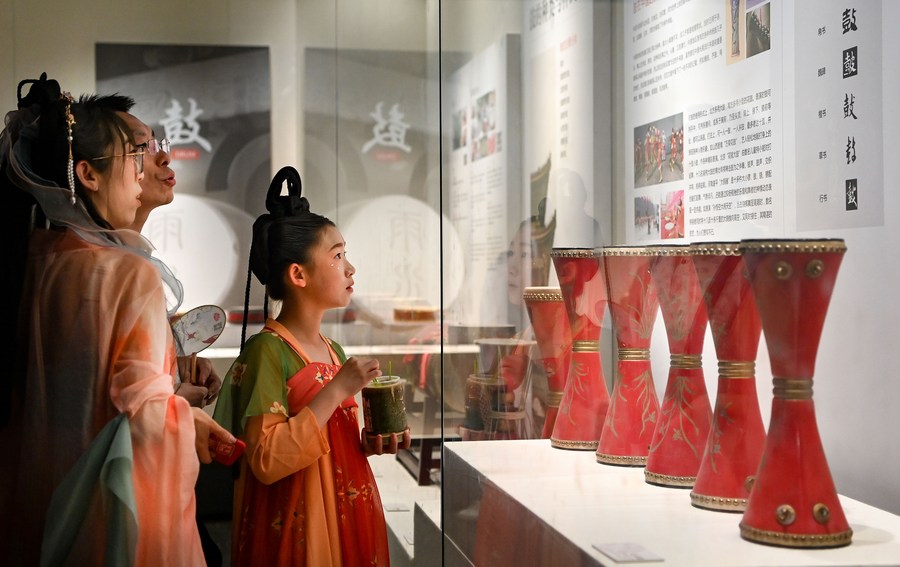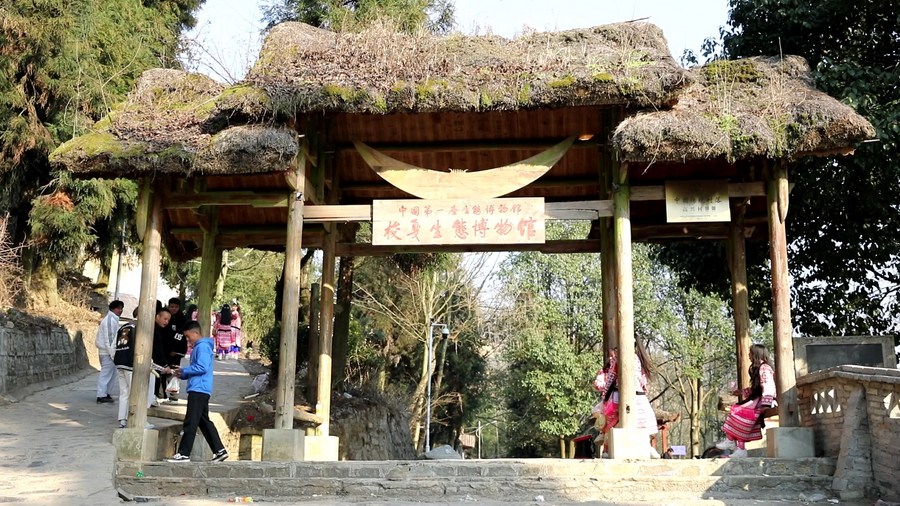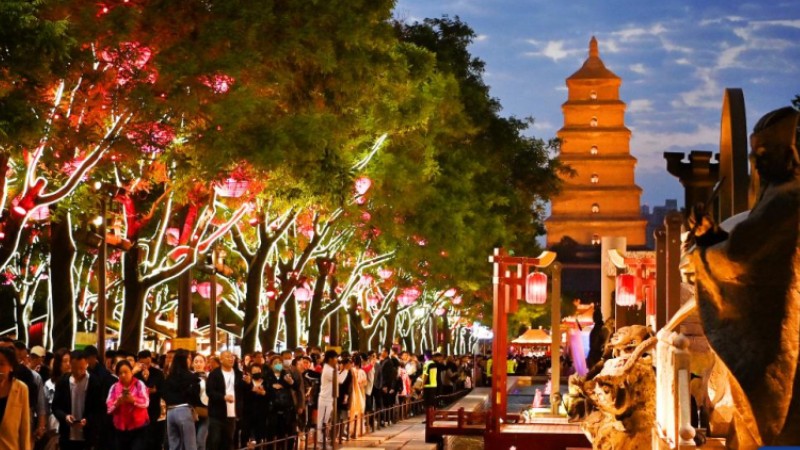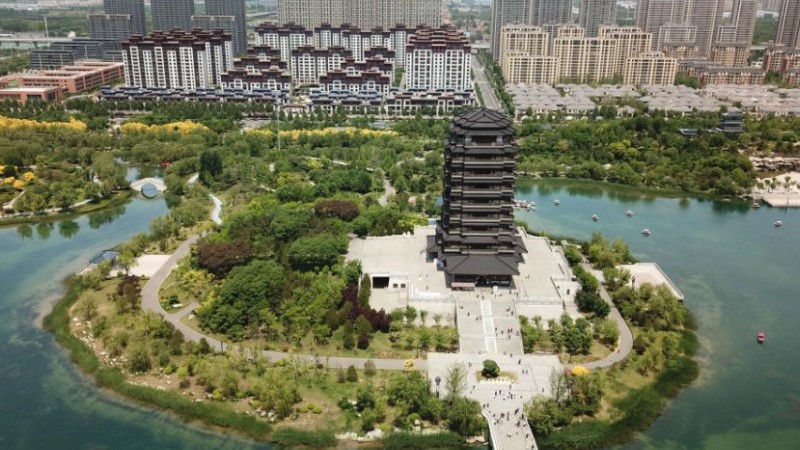Diversified museums empower sustainable development, better lives

Tourists visit Xi'an Bell and Drum Towers Museum in Xi'an, capital of northwest China's Shaanxi Province, May 1, 2023. (Photo by Zou Jingyi/Xinhua)
BEIJING, May 16 (Xinhua) -- During this year's May Day holiday, Ma Hualin, a student at Beijing University of Chemical Technology, visited a special bazaar showcasing cultural products from dozens of museums in Beijing, capital of China.
"I have collected seals from multiple museums today, and each can be seen as a cultural imprint for me," said Ma.
Ma is just one of the numerous tourists participating in this museum-themed market, which marks the beginning of the first museum activity month in Beijing. The month-long itinerary is among the city's latest moves to celebrate International Museum Day, which falls on Thursday.
Under the theme of "Museums, Sustainability and Wellbeing," this year's International Museum Day will also see thousands of relevant activities organized for the country's ever-growing number of museum lovers.
In 2021, museums across China received more than 748.5 million visits, up 32.7 percent compared to 2012, data from the Ministry of Culture and Tourism showed.
REACHING RURAL REGIONS
While integrating into the cultural life of city dwellers, museums are also thriving in the countryside to meet the burgeoning cultural demands of rural residents.
The city of Shaoxing, located in east China's Zhejiang Province, is known for being the hometown of Lu Xun, one of the most revered 20th-Century writers in China. The writer's grandmother's house in a local rural area is now a museum, where visitors can enjoy an immersive experience of the literary master's childhood.
Based on its rich cultural resources, Shaoxing has already built over 200 rural museums with a variety of themes including revolutionary history, intangible cultural heritage, and local customs.
Such types of museums have been sprouting in Zhejiang, as the local government has planned to build 1,000 rural museums within five years starting from 2021.
"The construction of rural museums is aimed at preserving the roots of rural culture, and enabling them to flourish in the new era," said Yang Jianwu, head of the provincial cultural heritage bureau.
Last year, the province issued a detailed guideline on the construction of rural museums, in a bid to ensure their well-regulated development. According to the guideline, rural museums are encouraged to be open to the public for free.
"MUSEUM WITHOUT WALLS"
Far from the coastal province of Zhejiang, Suojia museum in southwest China's Guizhou Province presents another view to visitors. Nestling in the mountains, it offers a glimpse into how a museum helps with both cultural and ecological protection.

This photo taken on Jan. 31, 2023 shows the main entrance to the Suojia ecomuseum in Suojia Miao, Yi and Hui Township of Liuzhi Special District, Liupanshui, southwest China's Guizhou Province. (Xinhua/Zhou Xuanni)
The ecomuseum, a concept which originated in France in the 1970s, is a new type of museum designed to combine human endeavors in cultural heritage preservation with those in environmental protection. In an ecomuseum, the cultural heritage is kept in its original state, rather than being confined in a traditional museum.
The first of its kind in China, the Suojia ecomuseum was established in 1998 to protect the natural and cultural heritage of the Qing Miao people, a special branch of the Miao ethnic group in China, characterized by the horn-shaped head ornaments and exquisite traditional costumes they wear.
The Suojia ecomuseum covers a complete Qing Miao community of 12 villages distributed across an area of over 120 square kilometers, with costumes, language, music and even the manner of production all serving as "living exhibits" in it.
During the past 25 years, apart from protecting local culture through cultivating talents with costume-making skills and other means, the local government also endeavored to improve the quality of the ecological environment.
"Thanks to the government's afforestation efforts and people's growing awareness of environmental protection, the mountains around the ecomuseum are filled with lush vegetation," said Luo Gang, curator of the Suojia ecomuseum, adding that over 70,000 tourists from home and abroad come to visit the ecomuseum every year.
GOING DIGITAL
In addition to offline exhibitions, technology-powered "online museums" are also providing Chinese people with more access to cultural feasts.
In mid-April, an interactive digital platform of a virtual duplication of the Library Cave in the Mogao Grottoes, a UNESCO World Heritage site in Dunhuang, northwest China's Gansu Province, was launched to the public.
The platform is "the world's first interactive museum beyond time and space," according to Dunhuang Academy, since it reproduces the historical scenes of the Library Cave over one hundred years ago in the digital world through advanced gaming technologies. Visitors can experience role-play and "time travel" to ancient dynasties and interact with eight historical figures, immersing themselves in the Dunhuang culture.
"More and more museums have managed to stay open online," said Zeng Pan, an official with the provincial museum of central China's Hubei Province, adding that these online museums can expose visitors to multi-dimensional information through new means, thus enabling them to have a better understanding of the historical background and artistic value of cultural relics.
Photos
Related Stories
Copyright © 2023 People's Daily Online. All Rights Reserved.









